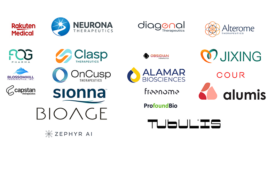
[Adobe Stock]
Harnessing the power of machine intelligence is increasingly a priority owing to the surging volumes of data in the field. Contributing to the trend are advances in radiological imaging, genomics as well as the continued evolution of electronic health records and personalized medicine. The healthcare industry is emerging as one of the biggest producers of data with RBC Capital Markets estimating that the sector now produces roughly 30% of the world’s data volume. RBC projects that the compound annual growth rate of data for healthcare will hit 36% by 2025 — significantly faster than in manufacturing, financial services, and media and entertainment.
Taming the healthcare data deluge

Ben Newton
Amidst this data deluge, the promise of AI in healthcare is more of a complement to human intelligence than a replacement for human expertise. In the recent past, some radiologists, for instance, worried about the prospect of full automation of image reading. “I think what’s very clear is, that’s not going to happen,” he said. Instead, technologies such as deep learning and machine learning algorithms have optimized the speed and accuracy of image analysis, accelerating the volume of reads without compromising quality. “What is going to happen is AI can be used in a way that will support radiologists to do a higher volume of reads,” Newton said.
Similarly, Haley Schwartz, CEO at Catalyze Healthcare, noted in the episode, and here as well, that not only is data volume in the field accelerating, but the quality of the data is emerging as a growing priority as well. “It’s really about quality of data and not just volume of data,” she summarized. The power of compute and quality of algorithms are also steadily improving, paving the way for AI systems that not just aid in screening but also support diagnostic and therapeutic applications.
Unlocking the power of multimodal AI requires a strategic approach

Haley Schwartz
The field stands to advance further with the advent of multimodal computing. Traditionally, many AI systems in healthcare have focused on data in discrete, unimodal environments such as in imaging. But now, it is growing more common to link data from sources spanning domains spanning demographics, pathology, imaging, and genomics. This connecting of the dots can lead to improved predictive power as well as improved quality of decision-making for patient care.
The implementation of AI in healthcare is perhaps uniquely challenging, however, in several respects. Hurdles to navigate include patient security, ensuring data integrity, ensuring AI systems can adapt to the nuances of human workflows. But as AI systems become more increasingly integrated into clinical workflows, the synthesis of human expertise and machine intelligence is poised to become ever-more synergistic.
Again, here multimodal data promises to be transformative, leading Newton to envision a future where AI not only aids in the present diagnosis but also augments the prognostic capabilities of healthcare professionals. Bridging imaging data with other sources could lead to systems that are increasingly predictive. Such a transition would represent a 180 degree shift away from “what has happened” to a more forward-looking approach, where the focus is on predicting ‘what may happen,” Newton said. “That prognostic power is huge,” he added, highlighting its role in determining the most effective treatment strategies. Given the possibilities, radiologists have reason for optimism given their involvement as diagnosticians.
AI takes a village
Achieving such outcomes, however, will take close collaboration across the industry with Big Tech companies also playing a role. “It will take a village,” Newton said, highlighting the need for working with cloud partners, academic centers, and data scientists to create the foundation models that will translate AI visions for AI systems into tangible improvements in patient outcomes and healthcare professional workflows.
Recognizing that it takes a village, clinicians will play a critical role in ensuring the successful adoption of AI in healthcare. As Schwartz emphasized, physician involvement is essential for building trust in AI systems and effectively integrating them into clinical workflows, especially for high-acuity patients. Clinicians need to be present at the bedside as AI algorithms “practice under their licenses.” Ultimately, it’s a human in the loop that must retain responsibility and accountability for patient care decisions and outcomes. “I think that’s one big piece,” Schwartz concluded.
Filed Under: Oncology



